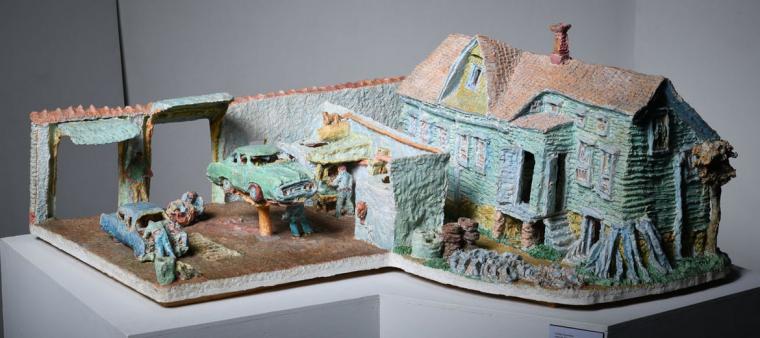
Adolph Rosenblatt's "Imperial Motors" in the Figge Art Museum's “New American Scene: Recent Acquisitions to the Figge Collection" -- through March 7.
Through Sunday, March 7
Figge Art Museum, 225 West Second Street, Davenport IA
Natural depictions of American subjects will soon be on glorious display at the Figge Art Museum, as the Davenport venue showcases noted 20th-century artists and their timeless works in New American Scene: Recent Acquisitions to the Figge Collection, the latest Gildehaus Gallery exhibition on view through March 7.
American Scene painting is a naturalist style of paintings and art particularly popular during the first half of the 20th century. The artists of the movement depicted scenes of typical American life and landscape, painted in a naturalistic, descriptive style. “American Scene” is an umbrella term for the rural American Regionalism and the urban and politically-oriented Social Realism, but its specific boundaries remain ambiguous. After World War I many United States artists rejected the modern trends stemming from the Armory Show. Instead, they chose to adopt academic realism in depicting urban and rural scenes. Much of the American scene painting conveys a nationalism and romanticism of everyday American life.
An anti-modernist style and reaction against the modern European style, American Scene painting was seen as an attempt to define a uniquely American style of art. The term does not signify an organized movement, but rather an aspect of a broad tendency for American artists to move away from abstraction and the avant-garde in the period between the two world wars. Thomas Hart Benton, John Steuart Curry, and Grant Wood were the three major representatives of Regionalism, all of whom studied art in Paris but declared their goal to create an art form that would be truly American. These artists insisted that the real solution to the many and growing problems of urban American life, made clear by the Great Depression, was for the United States to return to its agrarian roots. The art produced by the American Scene artists was ambiguous and cultivated, and it drew from diverse cultures. The choice of subjects might have attested to a quest for identity.
Some of the most prominent artists in the Figge's collection are associated with the American Scene movement, including Wood and Benton, who depicted rural communities, and artists such as Edward Hopper, who were focused on life in the city. New American Scene will feature recent acquisitions by artists who examine this same subject matter through a contemporary lens, including works by Adolph Rosenblatt, Rose Frantzen, and Mark Messersmith.
Museum hours are Tuesdays through Saturdays from 10 a.m. to 5 p.m., Thursdays from 10 a.m. to 8 p.m., and Sundays from noon to 5 p.m, museum admission is $4-10, and face masks and safe-distancing measures are required. For more information on New American Scene: Recent Acquisitions to the Figge Collection (on display through March 7), call (563)326-7804 or visit FiggeArtMuseum.org.










